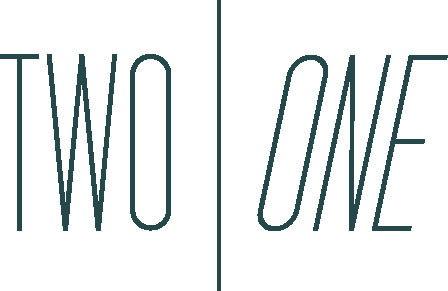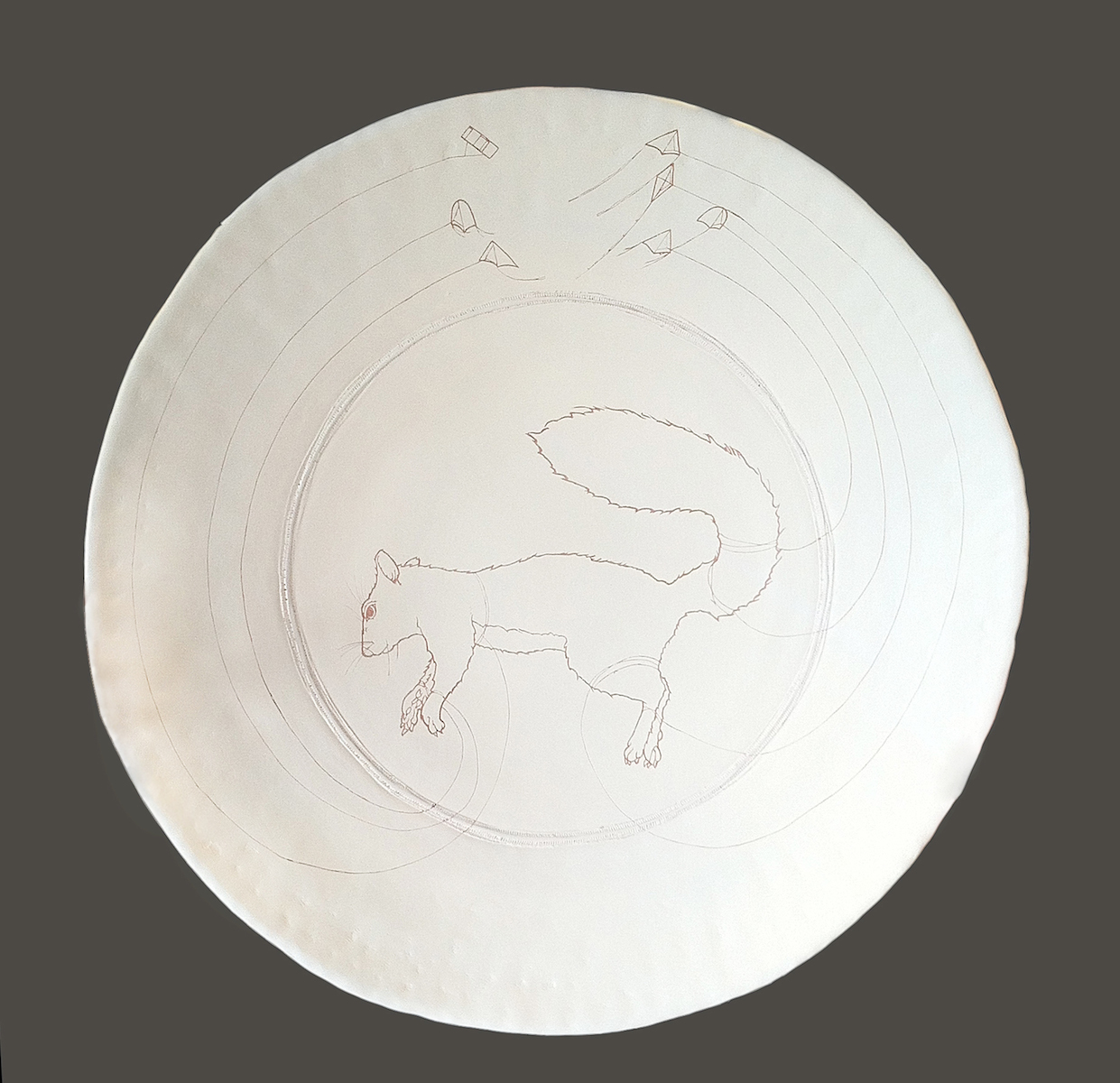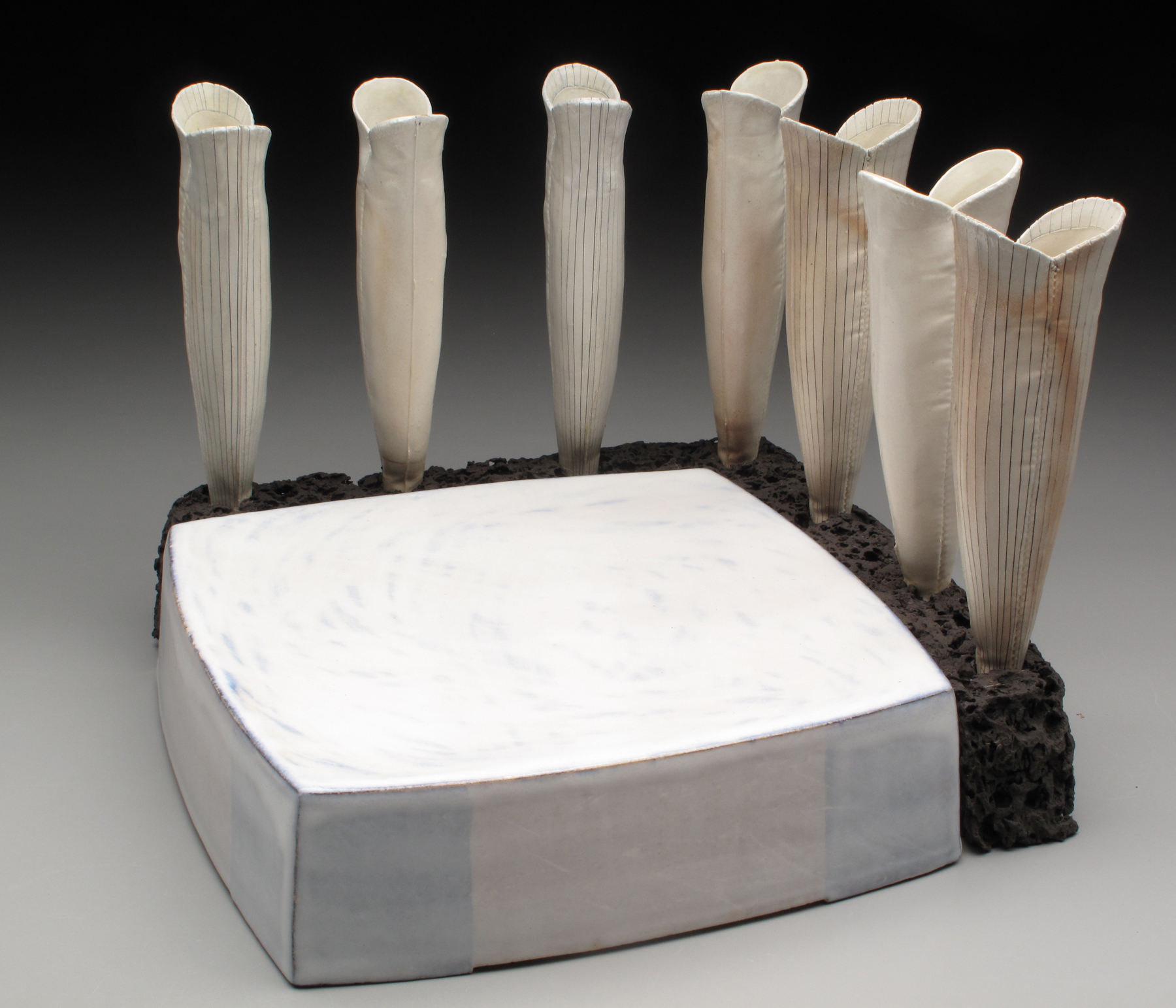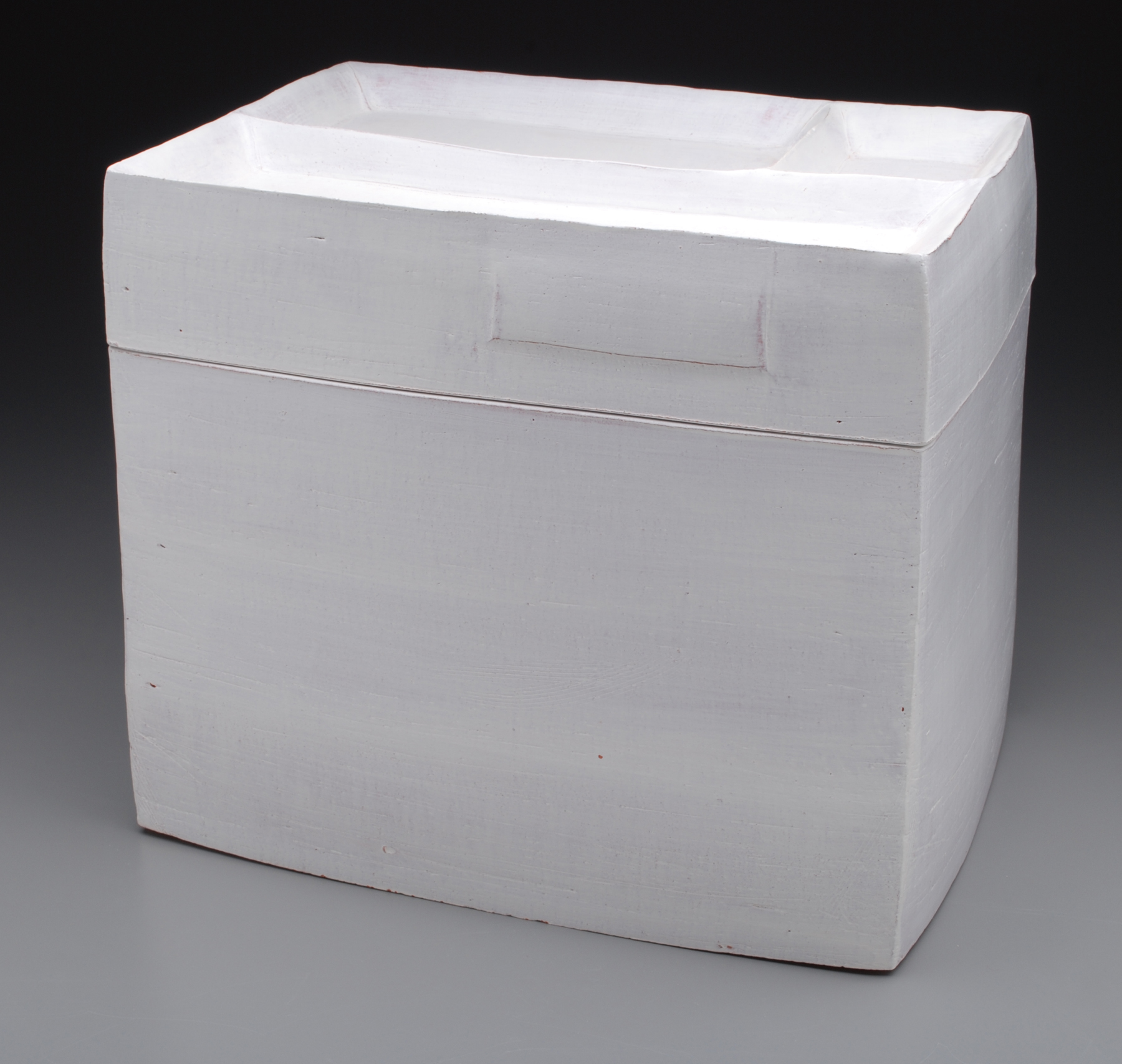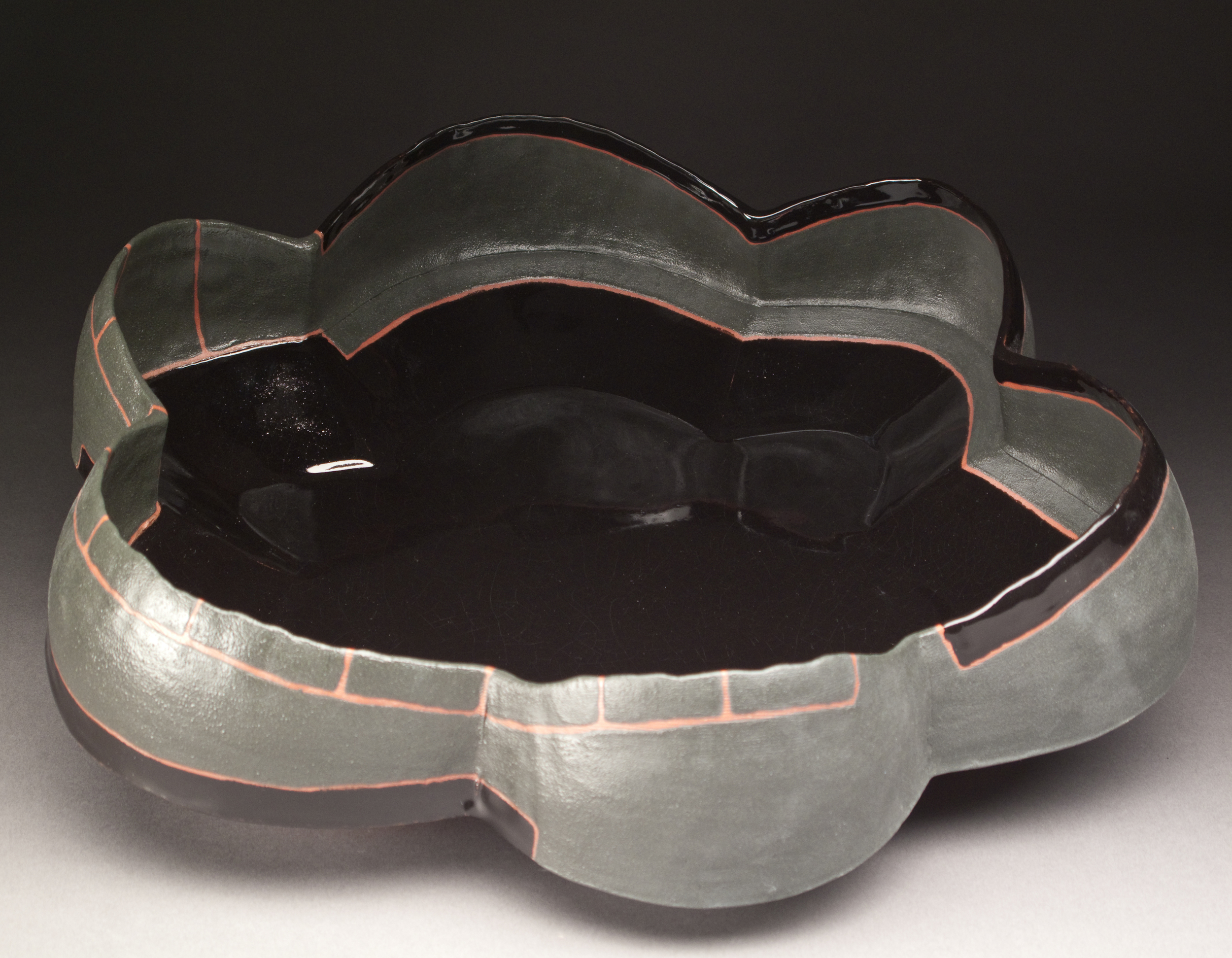David Eichelberger
Artist Statement
The making of a ceramic vessel can be approached from two directions: through the hands of The Potter, and through the vision of The Sculptor. Neither approach is exclusionary and overlap in aesthetic concerns is common. The spark to create the vessel, though, may start in one camp or the other.
The Potter in me is concerned with ergonomics, utilitarian grace, esteemed functionality, and the ritualistic honor a handmade vessel can attain. The aesthetic choices that lead to a finished vessel, according to The Potter, may relate to fundamental proportions of handles, lids, rims, and spouts, and the spirit those related elements collectively evoke. Pottery from history may be referenced, opening up opportunities to spotlight and commune with cultures from the past. Raw materials are selected: The Potter would choose to use porcelain because of its unique working characteristics and fine texture, for its immaculate color and potential translucency, and for its fired density and imperviousness. The ethos of this vessel emerges from The Potter’s skill acquisition, the veneration of the humble everyday objects that surround us, and the belief that great artistic accomplishments can be made from common materials and held in the hand. The Potter’s vessel is because it is, for the sake of its accumulated beauties. The Potter’s vessel sings with its truest, self-referential voice; a message may develop, but the qualities of the voice take precedence.
The Sculptor in me sees the process of vessel-making, the choice to mirror the paradigm of the traditional craftsman, and the materials used to build the object as the scaffolding of the piece’s content. This vessel is birthed and animated by the imbedded concept The Sculptor wishes to evoke and communicate. How the composition and balance of a piece adhere to, or reject, the conventions of “art” become tools the artist uses to broadcast their intent and establish the tone of their language. The choice to work with clay gives The Sculptor an arsenal of accumulated information – domesticity, ubiquity, laboratory ware, tea service, primitive technique and cutting-edge technologies, clunky utility and eggshell delicacy – perhaps more so that any other material in the human experience. The Sculptor might choose porcelain because of its historical associations with European wealth and alchemical pursuits, with Chinese royalty and traditions maintained for thousands of years, for its trade value through the vast developments of empires in Asia and the Middle East, for its geologic identity as a primary source material that is unsoiled by eons of erosion when compared to “common” clays. The Sculptor’s vessel has a definable statement rationalizing its existence, supported by its constituent parts. The Sculptor’s vessel sings a message; it may use a beautiful voice, or an intentionally ugly one, but the message takes precedence.
My work capitalizes on both approaches: my love of material and process is borrowed and dissected, then used as a tool and metaphor. The objects I make are both an anthropological study and an artistic endeavor, and incorporate an attempt to understand and reflect the world we live in, through making. Information flowing in from our environment is transformed in our minds into an understandable narrative that allows us to navigate through life. My work aims to pause this assimilation, to extend that experience, and to open it for investigation. I am focused on the “object-ness” of objects, particularly those that exist in the overlap between the commonplace and the venerated. By excavating into the foundation of vessel forms, and probing the formal “genetics” of an object, I hope to communicate through a more universal conduit based on the aesthetic notions of our shared human experience.
The materials I use and the intentional placement of edges and volumes in my work can convey a specificity of function and propose an intended purpose. The exact function may be vague, and a situation is created that pairs a sense of knowing with a sense of mystery. The desire to identify the purpose of an object is an opportunity; as humans, we seek order and resolution. Gently undermining this pursuit accentuates the initial impulse towards order, and opens it for scrutiny.
I compose elements in a regular, metered fashion, and a rhythm develops, with a cadence that promotes a rambling exploration of forms. Inspection reveals both undulations in edges once considered straight, and subtle variations on flat planes. These details act as rewards for a heightened level of engagement. A simple palette highlights pinch marks in the clay, direct evidence of the time and labor committed to my work to instill a sense of value born of enduring dedication, persistence, and patience.
Drawn images on some pieces employ loose narrative structure, resolvable by accessing one’s own life experiences. I select subjects with potential, drawn in pairs and groups, awaiting activation. Simple stories in the images are reminiscent of quiet, routine endeavors, and grant them a legitimacy, an importance, sometimes overlooked. The idea of celebrating mundane daily activities reflects the notion of elevating the ceramic vessel from a functional object to a contemplative sculpture, a meditation, a poem made material.
By assembling ceramic borders, interior spaces become charged. In the generation of an object, an interior is born that demarcates and defines itself. Success is achieved when I create space inside a vessel that appears to have its own character and agenda. Swelling and inflating beyond the walls, or contracting into a vacuum, the space inside is both objectively static and subjectively active, still and moving, eternally poised for reanimation.
The composed nature of my work suggests an unvoiced logic, a focal point of my investigations. My endeavor is a disciplined approach, aimed to augment one's engagement with their surroundings, achieved through my efforts to create objects in a thoughtful and reflective manner.
Bio
In the past couple of decades (and not exactly in this order), David has graduated from college (B.F.A., Virginia Tech, Blacksburg, VA), worked three years in a ceramics business (Santa Fe Clay Co. Santa Fe, NM), spent a total of seven years as a resident artist (at three different institutions: The EnergyXchange, Bakersville, NC; The Appalachian Center for Craft, Smithville, TN; Penland School of Craft, Penland, NC), received his Masters degree (University of Nebraska-Lincoln, Lincoln, NE), taught art at five universities and colleges (see CV), and received numerous awards and grants (again, see CV, please). He also got married and had three spectacular children. He is currently the Co-Owner of TWO-ONE Ceramics in Brattleboro, Vermont. Some of the time, he teaches part-time, and sometimes he works in his part-time studio all of the time.
When in the studio, David pursues both TWO|ONE Ceramics with his wife, Elisa, and makes his own solo work, shown in galleries across the country. The combination of teaching, developing new prototypes for TWO|ONE, and making gallery work somehow keeps his days rather full, happily.
Click to View David's Curriculum Vitae
